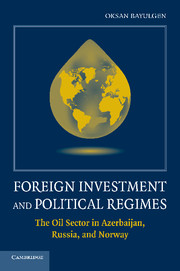Book contents
- Frontmatter
- Contents
- List of Figures and Tables
- Acknowledgments
- 1 Introduction
- 2 Political Risks in Oil Investments: A History of Antagonistic Interdependence Between Companies and Host-Governments
- 3 With or Without Democracy? The Political Economy of Foreign Direct Investments
- 4 Curse or Blessing? Effects of FDI on Development
- 5 Azerbaijan: One-Stop Shopping
- 6 Russia: Two Steps Forward, One Step Back
- 7 Norway: Icon of Stability
- 8 Beyond Three Cases and Oil
- 9 Conclusion
- References
- Index
5 - Azerbaijan: One-Stop Shopping
Published online by Cambridge University Press: 03 May 2010
- Frontmatter
- Contents
- List of Figures and Tables
- Acknowledgments
- 1 Introduction
- 2 Political Risks in Oil Investments: A History of Antagonistic Interdependence Between Companies and Host-Governments
- 3 With or Without Democracy? The Political Economy of Foreign Direct Investments
- 4 Curse or Blessing? Effects of FDI on Development
- 5 Azerbaijan: One-Stop Shopping
- 6 Russia: Two Steps Forward, One Step Back
- 7 Norway: Icon of Stability
- 8 Beyond Three Cases and Oil
- 9 Conclusion
- References
- Index
Summary
Since the collapse of the Soviet Union, most of the former Soviet republics have been striving to become part of the global economy as new sovereign states. Among these states, Azerbaijan's performance in terms of attracting foreign investment has been the most impressive. According to the UNCTAD (2006), Azerbaijan has shown an “above potential” investment performance in more than a decade of its independence. In terms of the inward Foreign Direct Investment (FDI) performance index, of approximately 140 countries, Azerbaijan ranked the third highest during 1994–1996 and eighth highest during 1998–2000. FDI constituted approximately 65 percent of gross fixed capital formation in Azerbaijan between 1995 and 1999. Since the “contract of the century” in September 1994, Azerbaijan signed more than twenty oil contracts with 33 companies from 15 countries. According to some accounts, in the 1990s it has attracted the most FDI per capita of any state in the former Soviet Union. It was soon dubbed by many as the former Soviet Union's “showcase” for the art of doing business, the “frontier of global capitalism,” and a “united nations of oil.”
The untapped oil and gas reserves of Azerbaijan – onshore and offshore in the Caspian Sea region – certainly explain the initial interest of international oil companies. Azerbaijan has approximately 7 billion barrels of proven oil reserves (with additional possible reserves at 32 billion barrels) and 30 billion barrels of proven gas reserves (with additional possible reserves at 35 billion barrels).
- Type
- Chapter
- Information
- Foreign Investment and Political RegimesThe Oil Sector in Azerbaijan, Russia, and Norway, pp. 87 - 121Publisher: Cambridge University PressPrint publication year: 2010
- 1
- Cited by

